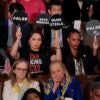Prior to Education Secretary Arne Duncan’s speech at the National Press Club this past Tuesday, we issued five questions for the Secretary to answer. Here’s what Duncan had to say in regard to each of the five topics we presented:
1. Support for Education Unions
The Daily Signal depends on the support of readers like you. Donate now
In his speech, Duncan touched on the need to “support accountability and a fair system of evaluation” for teachers, to allow them to “get better and hone their craft.” He took pride in the beginning of “a national conversation…to think boldly about how to create career pathways” for teachers as well as “how to boost their pay, attract great talent and ultimately transform the entire profession.”
But education unions stand in the way of these types of reforms—those that reward quality teachers and increase accountability. The outcomes of the Chicago Teachers Union strike are a poignant example of this, yet Duncan doesn’t see the disconnect, stating in a recent NBC interview that the outcomes of the strike are “great for children.”
2. Federal Overreach of Common Core Education Standards
Duncan boasted in his speech that as a result of the Administration’s Race to the Top competitive grant program, “45 states have now adopted internationally benchmarked, college and career-ready standards” (i.e., Common Core education standards). Duncan said: “The fact that 45 states have now adopted internationally benchmarked, college and career-ready standards is an absolute game-changer. Virtually the entire country has voluntarily raised expectations for our children.”
The reality is that states were required to adopt the standards to boost their chances of receiving Race to the Top money, and No Child Left Behind (NCLB) waivers have also been conditioned on states’ adoption of “college and career-ready standards.” The standards push is a clear federal overreach and one that will prove costly in terms of dollars and educational liberty lost.
3. School Choice
Absent from Duncan’s speech was any mention of school choice. While the Secretary heralded the need to assist low-income students—stating that “we must find the bipartisan will to address their needs and close the opportunity gap”—he turned a blind eye to how school choice programs are expanding opportunity in a growing number of states around the country.
One of these successful programs, currently in Duncan’s own backyard, is the D.C. Opportunity Scholarship Program, which has boosted graduation rates for the city’s most needy students.
Ironically, while Duncan speaks of closing the “opportunity gap,” the Administration has tried time and again to kill a program that is successfully opening doors of opportunity for the very group of students Duncan mentioned.
4. No Child Left Behind Waivers and True Flexibility for States
Duncan touted the Administration’s NCLB waiver plan, stating that it gives “local districts” flexibility, “instead of applying rigid, top-down mandates from Washington.” In reality, the waivers are anything but, replacing the federal overreach of NCLB with another federal overreach by requiring states to implement the Administration’s preferred policies in exchange for a waiver. The waivers fail to provide true flexibility and open wider the gates for increased federal control.
5. Education Spending
Duncan boldly stated that we need to “continue to fight hard” for federal education programs. He praised the efforts of the Administration to “protect” education jobs (via the $100 billion from the stimulus bill and the subsequent year’s $10 billion education bailout) but reported that the “money is mostly gone…and unfortunately there is little appetite on the Hill to help.”
But more spending is not the solution to improving education. This approach has failed for decades. Academic achievement and graduation rates continue to languish despite ever-increasing education spending.
Instead of allocating dollars to states through the federal government along with the massive red tape of federal regulations, states should have the opportunity to decide the best way for their dollars to be spent.
At one point in Duncan’s speech, he noted that “the real work of improving schools doesn’t happen in Washington but in cities and towns all across America—where parents, teachers, and community leaders work together toward a common goal.” He’s right. If only the Administration’s policies followed suit.
































